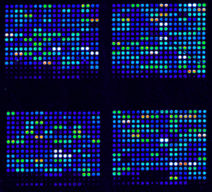Digital Protein Microarray
TECHNOLOGY NUMBER: 2023-128

OVERVIEW
- Employs a strategy of single molecule detection for signal amplification
- Allows for rapid multiplex quantification of samples from critically ill patients
BACKGROUND
Microarrays are a ubiquitous tool in life science research and consist of micro-patterned sensing spots on a rigid substrate, most often a glass slide. Protein or antibody microarrays have also been employed in integrated microfluidics systems given their ability to detect an extremely high number of analytes in a small volume. Though protein microarrays offer large multiplex capacity through spatial encoding, they universally suffer from poor limit of detection as well as measurement imprecision. These microarrays also lack in signal amplification as in enzyme-linked immunosorbent assays (ELISA) and show inconsistencies in protein patterning. As such, protein microarrays are not typically used for precise quantitative measurements in the same way as ELISA and are more often employed for broad-spectrum screening and proteomics studies. A need exists for an amplification strategy to improve the quantitative capabilities of protein microarrays while maintaining the multiplex capacity and capability for microfluidics integration.
INNOVATION
Researchers have created a device that provides a precise, quantitative, microarray-format measurement of a large number of biomarkers in liquid sample solutions. The device is called the Digital Protein Microarray (DPMA) and employs a strategy of single molecule detection for signal amplification. The DPMA is fabricated on a glass slide using a novel method of protein patterning, and it is readily integrated into a wide range of microfluidics devices. The platform includes two low-cost modules, a semi-automated fluidic dispensing/mixing module and a compact fluorescent optical scanner for near-bedside readouts. This single-molecule counting strategy improves the limit of detection and measurement precision of the traditional protein microarray while maintaining the spatial analyte encoding strategy for highly multiplexed measurements. The device can be used in settings where a digital protein microarray platform is needed for rapid multiplex quantification from critically ill patients, such as those who are admitted to intensive care units (ICUs) for COVID-19 infections.